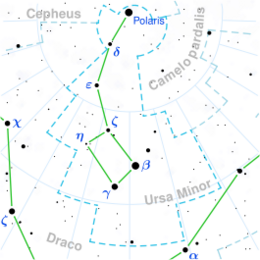Astronomy:HD 120565
| Observation data Epoch J2000.0 Equinox (celestial coordinates) | |
|---|---|
| Constellation | Camelopardalis |
| Right ascension | 13h 42m 23.18342s[1] |
| Declination | +82° 45′ 08.7103″[1] |
| Apparent magnitude (V) | 5.91±0.01[2] |
| Characteristics | |
| Spectral type | G9 III[3] |
| B−V color index | +1.01[4] |
| Astrometry | |
| Radial velocity (Rv) | −45.2±1.2[5] km/s |
| Proper motion (μ) | RA: +29.995[1] mas/yr Dec.: −43.734[1] mas/yr |
| Parallax (π) | 8.8109 ± 0.0364[1] mas |
| Distance | 370 ± 2 ly (113.5 ± 0.5 pc) |
| Absolute magnitude (MV) | +0.48[6] |
| Details | |
| Mass | 2.70±0.11[1] M☉ |
| Radius | 10.8+0.3−0.2[7] R☉ |
| Luminosity | 64.1±0.5[1] L☉ |
| Surface gravity (log g) | 2.47[8] cgs |
| Temperature | 4,993±122[9] K |
| Metallicity [Fe/H] | −0.20[10] dex |
| Rotational velocity (v sin i) | 2.6±1[11] km/s |
| Age | 503+75−70[1] Myr |
| Other designations | |
| Database references | |
| SIMBAD | data |
HD 120565, also designated as HR 5203, is a star located in the northern circumpolar constellation Camelopardalis. It is faintly visible to the naked eye as an orange-hued point of light with an apparent magnitude of 5.91. Gaia DR3 parallax measurements imply a distance of 370 light-years and it is currently drifting closer with a heliocentric radial velocity of −45.2 km/s. At its current distance, HD 120565's brightness is diminished by 0.12 magnitudes due to interstellar extinction[13] and it has an absolute magnitude of +0.48.[6]
HD 120565 has a stellar classification of G9 III,[3] indicating that it is an evolved G-type giant star. It has 2.7 times the mass of the Sun[1] but at the age of 503 million years,[1] it has expanded to 10.8 times the radius of the Sun.[7] It radiates 64.1 times the luminosity of the Sun[1] from its enlarged photosphere at an effective temperature of 4,993 K.[9] HD 120565 is metal deficient with an iron abundance 63.1% that of the Sun's or [Fe/H] = −0.22,[10] and it spins modestly with a projected rotational velocity of 2.6 km/s.[11] It was determined to be a single-lined spectroscopic binary by J.R. De Mederios and J. R. P. da Silva based on radial velocity variations.[11]
References
- ↑ 1.0 1.1 1.2 1.3 1.4 1.5 1.6 1.7 1.8 1.9 Vallenari, A. et al. (2022). "Gaia Data Release 3. Summary of the content and survey properties". Astronomy & Astrophysics. doi:10.1051/0004-6361/202243940 Gaia DR3 record for this source at VizieR.
- ↑ Høg, E.; Fabricius, C.; Makarov, V. V.; Urban, S.; Corbin, T.; Wycoff, G.; Bastian, U.; Schwekendiek, P. et al. (March 2000). "The Tycho-2 catalogue of the 2.5 million brightest stars". Astronomy and Astrophysics 355: L27–L30. ISSN 0004-6361. Bibcode: 2000A&A...355L..27H.
- ↑ 3.0 3.1 Cowley, A. P.; Bidelman, W. P. (February 1979). "MK spectral types for some F and G stars.". Publications of the Astronomical Society of the Pacific 91: 83. doi:10.1086/130446. ISSN 0004-6280. Bibcode: 1979PASP...91...83C.
- ↑ Haggkvist, L.; Oja, T. (1970). "Results of BV photometry 1969-70 (Uppsala refractor)". Private Communication. Bibcode: 1970Priv.........0H.
- ↑ Gontcharov, G. A. (November 2006). "Pulkovo Compilation of Radial Velocities for 35,495 Hipparcos stars in a common system". Astronomy Letters 32 (11): 759–771. doi:10.1134/S1063773706110065. ISSN 1063-7737. Bibcode: 2006AstL...32..759G.
- ↑ 6.0 6.1 Anderson, E.; Francis, Ch. (May 2012). "XHIP: An extended hipparcos compilation". Astronomy Letters 38 (5): 331–346. doi:10.1134/S1063773712050015. ISSN 1063-7737. Bibcode: 2012AstL...38..331A.
- ↑ 7.0 7.1 Brown, A. G. A. (August 2018). "Gaia Data Release 2: Summary of the contents and survey properties". Astronomy & Astrophysics 616: A1. doi:10.1051/0004-6361/201833051. Bibcode: 2018A&A...616A...1G. Gaia DR2 record for this source at VizieR.
- ↑ Anders, F. et al. (August 2019). "Photo-astrometric distances, extinctions, and astrophysical parameters for Gaia DR2 stars brighter than G = 18". Astronomy & Astrophysics 628: A94. doi:10.1051/0004-6361/201935765. ISSN 0004-6361. Bibcode: 2019A&A...628A..94A.
- ↑ 9.0 9.1 Stassun, Keivan G. et al. (9 September 2019). "The Revised TESS Input Catalog and Candidate Target List". The Astronomical Journal 158 (4): 138. doi:10.3847/1538-3881/ab3467. Bibcode: 2019AJ....158..138S.
- ↑ 10.0 10.1 Charbonnel, C.; Lagarde, N.; Jasniewicz, G.; North, P. L.; Shetrone, M.; Krugler Hollek, J.; Smith, V. V.; Smiljanic, R. et al. (January 2020). "Lithium in red giant stars: Constraining non-standard mixing with large surveys in the Gaia era". Astronomy & Astrophysics 633: A34. doi:10.1051/0004-6361/201936360. ISSN 0004-6361. Bibcode: 2020A&A...633A..34C.
- ↑ 11.0 11.1 11.2 De Medeiros, J. R.; Da Silva, J. R. P.; Maia, M. R. G. (20 October 2002). "The Rotation of Binary Systems with Evolved Components". The Astrophysical Journal 578 (2): 943–950. doi:10.1086/342613. ISSN 0004-637X. Bibcode: 2002ApJ...578..943D.
- ↑ "HD 120565". SIMBAD. Centre de données astronomiques de Strasbourg. http://simbad.u-strasbg.fr/simbad/sim-basic?Ident=HD+120565.
- ↑ Gontcharov, George A.; Mosenkov, Aleksandr V. (28 September 2017). "Verifying reddening and extinction for Gaia DR1 TGAS main sequence stars". Monthly Notices of the Royal Astronomical Society 472 (4): 3805–3820. doi:10.1093/mnras/stx2219. ISSN 0035-8711. Bibcode: 2017MNRAS.472.3805G.
 |


